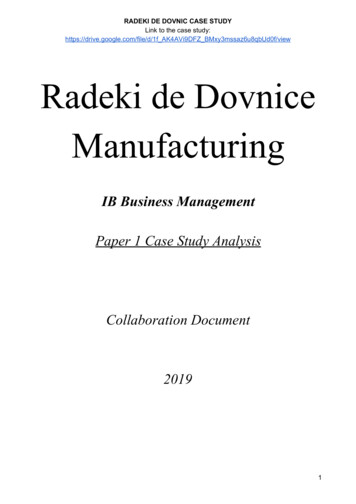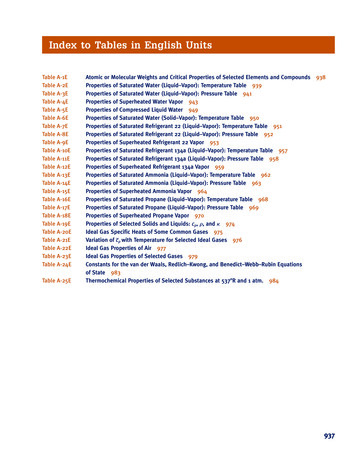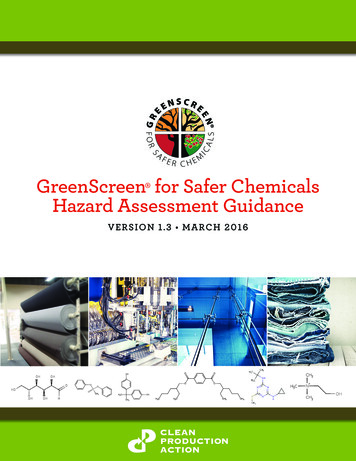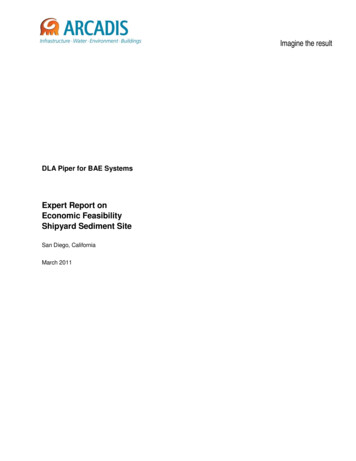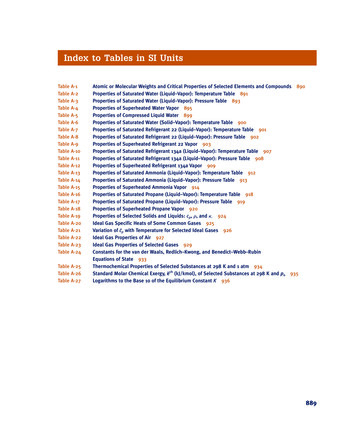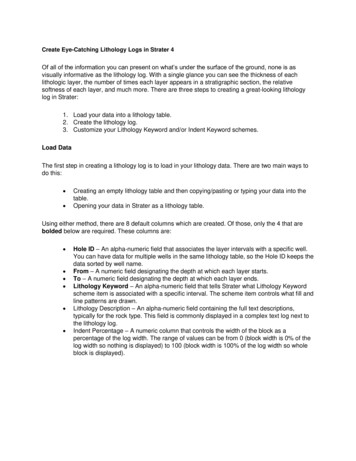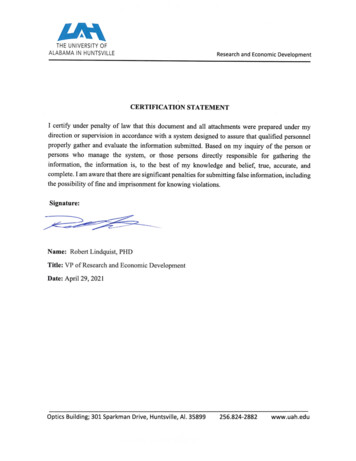
Transcription
Annual Report- 2020-2021 MMS4The University of Alabama in HuntsvilleTable of ContentsIntroduction .MS4 Description .Control Measures 112BMP: Public Education and Public Involvement on Storm Water Impacts .Web Resources .Measure Specific Evaluation .Measure specific activities planned for the next reporting period .234BMP: Illicit Discharge Detection & Elimination .Measure Specific Evaluation .Measure specific activities planned for the next reporting period .45BMP: Construction Site Stormwater Runoff Control .Design Engineers Responsibility .Contractor’s Responsibilities .Construction Site Inspections .Construction Site problem Solving 55556BMP: Post Construction Site Runoff .Protection of Sensitive Waters Local Interaction .UAH responsibilities . 6777BMP: Pollution Prevention / Good Housekeeping .Parking Lot, Parking Deck Cleaning Stormwater Conveyance system system . Wastewater Reduction and Recycling .Spill Prevention, Control Countermeasures (SPCC) . Used Oil Recycling .More Specific Evaluations .778889945
Annual Report- 2020-2021 MMS4The University of Alabama in HuntsvilleIntroductionThis Annual Report, for Year 4 for “Measurable Goals to Meet MEP Requirements of MS4”, wasdeveloped in accordance with the guidelines provided in Title 40 Code of Federal Regulations(CFR), Part 122.26(d) incorporated by reference in the Alabama Administrative Code 335-6 asadministered by the Alabama Department of Environmental Management (ADEM) and NPDESALR4040091 Phase II General Permit effective May 1, 2017.The purpose of this Annual Report is to describe the compliance efforts reflected in theUniversity of Alabama in Huntsville’s Storm Water Management Program Plan (SWMPP). TheAnnual Report will identify the control measure specific efforts undertaken by University ofAlabama in Huntsville from May 1, 2020 through April 30, 2021 to reduce discharge ofpollutants from University of Alabama in Huntsville’s campus to the Maximum ExtentPracticable (MEP) to protect water quality and to satisfy the appropriate water qualityrequirements of the Clean Water Act (CWA).This Annual Report is a result of a collaborative approach from individuals that represent bothacademic and operational areas of the campus. The multi-disciplinary effort continues to bestrengthened by its diversity and includes the following individuals and their areas ofresponsibility or interest:1. Mr. Greg Smith, UAH Facilities & Operations; Assoc. Vice President for Facilities & Operations2. Mr. Christian Reed, AIA, UAH Facilities & Operations, Senior Campus Architect3. Ms. Michell Roe, UAH Facilities & Operations; Senior Administrative Assistant4. Ms. Kristy Olive, UAH, Director of Office of Environmental and Safety5. Mr. James A. (Tony) Davis, UAH Facilities & Operations, Director of Facilities Maintenance6. Ms. Claire Jackson, UAH Director of Utilities and Sustainability8. Mr. Kevin Bennett, UAH Office of Risk Management, Director of Risk Management9. Mr. Troy Tolleson; UAH Director of Grounds and Landscaped Management10. Mr. Scott Royce; Assistant Dean of Students10. Mr. Nasser Amiri, PE; Amiri Engineering Corp; Environmental ConsultantMS4 DescriptionThe University of Alabama in Huntsville (UAH) is a public Tier 1 national university located inHuntsville, Alabama. UAH offers nearly 90 degree programs of study at the undergraduate andgraduate level, with colleges in Engineering; Education; Nursing; Science; BusinessAdministration; Arts, Humanities, & Social Sciences; Graduate Studies; and Professional &Continuing Studies. UAH is a fast growing University with current year’s record-settingenrollment of nearly 10,000. The current student population plus the faculty and staff does nottrigger the Standard Urban Storm Water Mitigation Plan (SUSMP) requirements for newconstruction projects.Actions taken during this reporting period are presented in this Annual Report and also in theMS4 document “Measurable Goals to Meet MEP Requirements” for Year 4 section.1
Annual Report- 2020-2021 MMS4The University of Alabama in HuntsvilleControl MeasuresStorm water management controls or Best Management Practices (BMPs) is implemented to theMEP to minimize pollution in storm water discharges from University of Alabama in Huntsville’sCampus. The Permit requires BMPs to be implemented to address five minimum control measuresto be part of the SWMPP. As required by Part III.B of the Permit, the Annual Report will describethe University’s efforts performed during this reporting period to implement the established BMPs(Public Education & Public Involvement on Storm Water Impacts, Illicit Discharge Detection &Elimination, Construction Site Storm Water Runoff Control, Post Construction Storm WaterManagement in New and Redevelopments and Pollution Prevention / Good Housekeeping forMunicipal Operations) and will include:1. The status of UAH’s compliance with Permit conditions, an assessment of theappropriateness of the identified BMPs, and progress towards achieving the statutorygoal for each of the minimum control measures.3. Results of information collected and analyzed during this reporting period, includingany monitoring data used to assess the success of the SWMPP at reducing dischargeof pollutants to the MEP.4. Update University of Alabama in Huntsville’s SWMPP.5. All monitoring results collected during the reporting period in accordance with Part V.of the Permit.BMP: Public Education & Public Involvement on Storm Water ImpactsStorm water pollution prevention education leads to an informed and knowledgeable campuscommunity that is more likely to support and comply with the BMP provisions. The targeted“Public” audiences of the University’s SWMPP are University of Alabama in Huntsville faculty,staff, students and visitors, which populate the campus on any given day. Within thesepopulations, only students in residence housing live on campus. All other students, employeesand visitors reside in the surrounding communities.Throughout this reporting period, University of Alabama in Huntsville initiated activitiesconsistent with the SWMPP and continued the activities that begin prior year and builtupon those. Some of those activities are as follow:Marketing Campaign: The marketing campaign’s purpose is to inform and educate the campuscommunity about the importance of properly managing storm water on campus and avoiding stormwater pollution. The campaign included Website announcements, Posters which were printed anddistributed and Medallions informing the campus community that storm drains flow to the riverwere placed on drains around campus.The stormwater working group continued to convene in 2020 and 2021 reporting period, in a morelimited schedule due to Covid 19 Pandemic, in a quarterly schedule. Meetings were held via Zoom,on September 17, 2020, November 19, 2020, and March 25, 2021. due to May and June beforeswitching to a proposed quarterly schedule. The latest meeting was in March 25, 2020, which,due to Campus shutdown due to Covid-19, was held via Zoom Web Conferencing/Meeting.2
Annual Report- 2020-2021 MMS4The University of Alabama in Huntsville Hannah Upton of OEHS installed storm drain markers at CCRH.Fabian LaPalme installed 8 new storm drain markers at MortonHall when construction was complete. Campus Organizations conducted litter cleanup events. The Fallevent had 30 participants and they collected 14 bags of trash.The Spring Event had 23 participants and they collected 6 13gallon bags of trash. OEHS and F&O also helped sponsor theEarth Day Event which included a Stormwater Table. A T shirtcontest was conducted, and T Shirt winners were announced. Campus cleanup effort by the Green Club of UAH and otherstudents was performed in three episodes during the reportingyear (May 1, 2020 through April 30, 2021). Onewas on November 17, 2020; one on March 15,2021, and one on Earth Day, on April 22, 2021.Levee cleanup continued this year. Levee cleanupwas conducted during the Campus cleanupefforts. Campus Organizations conducted litter cleanup events. TheFall event had 30 participants and they collected 14 bags oftrash. The Spring Event had 23 participants and theycollected 6 bags (13-gallon capacity) of trash. OEHS andF&O also helped sponsor the Earth Day Event whichincluded a stormwater table. A copy of the sign-up sheet (37slots signed up for) on Earth Day is presented in AppendixC. Due to Covid 19 Pandemic, Facilities and Operations (F&O)and Office of Environmental Health and Safety (OEHS) werein a state of emergency operations throughout the summer of2020, and classes were also closed from Thanksgiving untilJanuary 2021. The final Stormwater Working Group meetingof this cycle was March 25, 2021. During the events where students and staff were present,educational materials were distributed and/or placed ondisplay. Photograph of one of such events, during the EarthDay which Storm Water Control Poster was in display, ispresented here. Posted storm water pollution prevention information is presented on the website of OEHS.3
Annual Report- 2020-2021 MMS4The University of Alabama in HuntsvilleWeb ResourcesInformation related to water quality and storm water management continues to be providedfrom a wide variety of University of Alabama in Huntsville websites. The UAH Office ofEnvironmental Health and Safety (OEHS) is the central web resource specific to the SWMPPand the requirements of the Phase II General Permit NPDES ALR4040091 through the webpageis presented at www.uah.edu/oehs/stormwater. The University of Alabama in Huntsvillewebsites which provide information relating to storm water BMPs include: Office of Environmental Health and Safety https://www.uah.edu/oehsDept. of Atmospheric Science: eEarth System Science: www.nsstc.uah.edu/ess/ess bs.htmlCivil and Environmental Engineering: www.uah.edu/eng/departments/ceeOffice of Sustainability; www.uah.edu/sustainabilityFacilities and Operations: www.uah.edu/facilities-and-operationsMeasure Specific EvaluationThroughout this reporting period, University of Alabama in Huntsville continued to foster anopen and collaborative relationship with different groups on and off campus to improve andprotect water resources to engage and to train a local network for the continued efforts by theOffice of Sustainability. Through these continued efforts, our connectivity with theenvironment and the importance of storm water management is better understood.BMP: Illicit Discharge Detection & EliminationDuring this reporting period, University of Alabama in Huntsville continued to utilize the stormwater infrastructure engineering assessment to prioritize areas on campus requiring furtherassessment and/or repair along with field observations by UAH Facilities Management,Mechanical Shops, Resources and Risk Management & Safety to investigate sources of potentialillicit discharges. An updated map is attached to this report and identifies the storm waterconveyance system maintained by the University.Upon discovery, any potential illicit discharge is investigated further. In the Stormwater sectionof the Environmental Health & Safety page of the University’s website,https://www.uah.edu/oehs/stormwater, individuals are asked to call UAH Emergency to reportany illicit discharge. A variety of measures can be deployed to track the source of the illicitdischarge and may involve multiple UAH groups as well as the City of Huntsville as necessary.The proper management of waste and the prohibition of illicit discharges on campus continuedto be promoted by University of Alabama in Huntsville through a variety of guidancedocuments, design standards, recycling guidelines and contractual specifications:4
Annual Report- 2020-2021 MMS4The University of Alabama in HuntsvilleMeasure Specific EvaluationThroughout this reporting period, The University of Alabama in Huntsville was successful inmeeting the objectives of the Illicit Discharge Detection Elimination (IDDE) measure asdefined in the University’s SWMPP. Advance/improvements to the program are dependentupon an informed public. Continued educational efforts promoted by numerous groups oncampus are successful in increasing the campus community’s awareness towards proper wastemanagement procedures and services.Measure specific activities planned for the next reporting periodUniversity of Alabama in Huntsville will continue the Illicit Discharge Detection andElimination (IDDE) measures as defined in the University’s SWMPP. During the next reportingperiod, planned activities will include performing a campaign of IDDE to the UAH employees,students and visitors to increase community’s level of awareness to pollution prevention.BMP: Construction Site Storm Water Runoff ControlIn accordance with Part III (B) (4) of NPDES Permit No ALR04040091, University ofAlabama in Huntsville developed the Construction Site Storm Water Runoff ControlBest Management Practice. University of Alabama in Huntsville’s FacilitiesManagement is responsible for all construction projects on campus and implementationof this measure.During this reporting period, no new project was initiated that required storm water protectionmeasures to be implemented and maintained. However, one (1) project, Shelby Center whichwas an investigative demolition project was conducted between May and August 2020.Design Engineers responsibilities include: All UAH construction plans incorporate BMP's. Sediment and Erosion Control Plansare part of all applicable construction plans. Design the project so that Erosion and Sedimentation Control Standards are partof all projects greater than .25 acres. Design must include three phase (pre-construction, construction and postconstruction) Erosion Sedimentation Control Plan.Contractor responsibilities include: Maintain Best Management Practices Plans on their project.5
Annual Report- 2020-2021 MMS4The University of Alabama in HuntsvilleConstruction Site InspectionField inspections associated with Construction Storm Water Runoff protection on both projectshave been conducted by a Professional (Registered) Engineer with Amiri EngineeringCorporation. The inspections have included QCI/QCP inspections per ADEM Registration andare to be under observation of the QCP/PE associated with the permit.Construction Site Problem ReportingThere have been no public reports related to construction site problems. UAH’s Facilities and Operation is responsible for all construction projects on campus andimplementation of this measure. Campus Architect’s office and Amiri EngineeringCorporation, a Consulting Environmental Engineering firm, will review ConstructionStorm Water Control Program on new constructions projects to verify that they meetUAH Construction storm water programs.Construction sanctions/penalties: Failure by the General Contractor to meet therequirements, as set forth in the project specifications, would be considered a default inthe contract. Therefore, General Contractor would be responsible for all associated costsand damages, including remedial measures to comply with Construction StormwaterRun-off Control and ADEM NPDES Permit requirements.Project managers were reminded prior to initiation of the construction, about UAH ‘spolicies about Construction Storm Water Control. Since majority of UAH watershedenters the two (2) lakes in the southwestern portion of the campus, surface run-off fromthe construction sites typically enters the lake system, through surface runoff and stormsewer lines, and sediment is generally deposited in the upper (northern) lake before ifexits over the weir of northern lake and enters the drainage structure and southern lake.Specific discussions are made to minimize any erosion and loss of fines into the lakes.Project Managers and contractors were reminded during the pre-construction meetingsabout implication of the erosion and sediment that leaves the jobsite and ends up in thelake system and/or the creeks that run through the campus.ADEM NPDES Construction Storm water Inspection form will be used during each siteinspection associated with Construction Storm water runoff is conducted. This requiresan inspection by the Qualified Credentialed Professional (QCP) after every ¾ inches ofrain event in 24 hours period or at least one inspection per month, whichever is more. Inaddition, site inspections are to be made after 0.5 inches of rain in 24 hour period to meetthe MS4 program.BMP: Post Construction Site RunoffThis control measure incorporates BMP's that are designed to minimize water quality impactfrom developments once construction is complete. During the course of this reporting period,6
Annual Report- 2020-2021 MMS4The University of Alabama in HuntsvilleDuring this year, Post Construction BMP Inspection procedures was prepared by for UAH projects, byAmiri Engineering Corporation. A copy of the Post Construction BMP Program is attached in AppendixC.Protection of Sensitive WatersThe 303(d) listing of impaired waters is routinely reviewed to ensure that local bodies of waterwhich receive storm water runoff are not listed.Local InteractionDuring the course of the reporting period, several attempts were planned by Assistant VicePresident of Facilities and Operations, to meet with Ms. Kathy Martin, Engineering Manager ofCity of Huntsville, to discuss improvement of Drainage Channels which enter UAH from the Cityof Huntsville. However, due to covid 19 Pandemic, meetings were cancelled.UAH responsibilities included: Assign Project Manager for all sites.Review and approve Dig Permit requests.Contract with Engineer of Record for the NPDES Permit to perform QCPinspections at least monthly, before forecasted rain events and within 48 hoursof a Rain Wave flagged 0.5” or greater event.Notify contractors of all reported violations or BMP failures and inform themthat corrections are to be made within 24 hours. If the contractor is nonresponsive ADEM is to be notified.BMP: POLLUTION PREVENTION / GOOD HOUSEKEEPINGParking Lot, Parking Deck, Street Cleaning ProgramGrounds Management Group at UAH coordinate the use of street sweepers on a monthly basisto address the removal of accumulated debris from parking lots, parking decks, streets,pedestrian walkways and sidewalks. Grounds Management Personnel provide at least weeklyinspections of streets, street drains and curbs. During fall and winter months, GroundsManagement removed leaves and other debris on a work daily basis throughout the campus.Grounds Management also incorporates the use of a large vacuum that allows the landscapedebris, which is harvested on campus grounds, to be removed before it is introduced into astorm drain system. Mowers with mulching equipment pulverize leaves, limbs and debris onsite which reduces possible storm drain blockage. This process is used during the spring andsummer months unless storms or high winds cause leaves, limbs and debris to cover the campusgrounds and streets; at that point the same procedures as the fall and winter removal are used.During this reporting period, coordination continued with the contractors to ensure that softwash program for buildings on campus uses an environmentally friendly cleaning process andthat the rinse water will not enter the storm drains.7
Annual Report- 2020-2021 MMS4The University of Alabama in HuntsvilleStorm Water Conveyance System Cleaning ProgramThe University of Alabama in Huntsville, Grounds Management group, inspects all storm waterconveyance outfalls routinely throughout the year. This is done after each heavy rain or stormactivity. If any large limbs, trees, or debris are blocking the area, the blockage is removed asquickly as possible. Lakeside maintenance to include invasive plant removal is also performed.To facilitate the inspection process, a Drainage Inventory Map, presented in Appendix C, wasprepared during the past years. This map shows all Manhole locations and street side dropinlets throughout the campus.During this reporting period, stormwater drain systems were checked, and drainage inletsystems which appeared to be deficient were prioritized. A contractor was contracted to repairthe drain systems which, based on prioritization, needed immediate attention. The repairs weredone by the contractor. Correspondence about contracting and payment of this work is attachedin Appendix C.Waste Management Reduction & RecyclingDaniel Boutwell, Director of Custodial Services at UAH manages the Recycling Wasteon the campus and works with faculty, staff, and students on a daily basis to provideeasy and convenient recycling.The Director of Custodial Services manages the campus building recycling program, game dayrecycling, office clean-outs, indoor/outdoor event trash and recycling bins, secure documentshredding services. Electronics recycling is handled by the Central Receiving.Waste reduction and recycling initiatives are also promoted through education and outreach oncampus and in the surrounding community. The UAH maintained a contract with WasteManagement (WM).Spill Prevention Control & Countermeasure (SPCC) ProgramUniversity of Alabama in Huntsville maintains compliance efforts consistent with 40 CFR 112and the University’s SPCC Plan. The SPCC Plan addresses the University’s program to manageoil and other petroleum products defined by 40 CFR 112.7(2) and 40 CFR 112.7(4). Thisincludes the management of fuel oils, gasoline, lubricating oils, hydraulic and dielectric fluidsas they are utilized and stored on University of Alabama in Huntsville’s campus. The Universityinspects all applicable containers (fuel tanks, generators, elevators and drums) monthly and alltransformers annually. These routine inspections evaluate the condition of the containers toensure proper functionality and management to prevent releases to the environment.For the upcoming reporting period, training will continue for oil handling personnel employedby University of Alabama in Huntsville to further promote the objectives of the SPCC Plan,the regulatory responsibility associated with these regulated materials and to address in-houseprocedures necessary to respond to spills or releases from them.8
Annual Report- 2020-2021 MMS4The University of Alabama in HuntsvilleUsed Oil Recycling ProgramDuring this reporting period, University of Alabama in Huntsville’sGrounds Management (Garage Group) routinely collected used oil,which was picked up by Holston environmental Services, Inc ofChattanooga, Tennessee for removal and recycling.Measure Specific EvaluationThroughout this reporting period, the on-going preventative measures taken by multiple groupson campus have removed items that could have been ultimately destined to our local landfill,groundwater and or surface waters. The University promotes waste minimization efforts toinclude regulated hazardous and non-hazardous wastes, e-waste and construction anddemolition waste through reuse and recycling. Picture presented in this page is a sample ofrecycling efforts placed at UAH Website.The University has developed sound practices to manage equipment and operations to minimizereleases to the environment and provides training to University and contractual employees onthese best management practices. Per the newly issued permit, UAH began efforts to inventory“municipal facilities”.9
Annual Report- 2020-2021 MMS4The University of Alabama in HuntsvilleAppendix AStorm Water Management Program Plan (SWMPP)All Rights Reserved. No part of this document may be reproduced, or transmitted in any form, including photocopying,recording or by other electronic or mechanical methods, without the written permission of the Amiri Engineering Corporation.
The University of Alabama in HuntsvilleStorm Water Management PlanNPDES Phase II Storm Water ManagementPlan (MS4)PREPARED BY:AMIRI ENGINEERING CORPORATION2609 Artie Street SWHuntsville, Alabama 35805256 536-9992www.amiriengineering.com.
The University of Alabama in HuntsvilleStorm Water Management Plan.TABLE OF CONTENTS1.0 Introduction1.1 Regulatory Background . 11.2 Purpose of the SWMP .11.3 SWMP Development Committee .11.4 The Storm Water Management Plan 21.5 Minimum Control Measures 21.6 Contact Lists 32.0 Site Information .42.1 Facility Description . .42.2 Facility Operation .43.0 Description of Potential Sources of Pollution . 53.1 Potential Pollutant Sources .54.0 Minimum Control Measures 54.1 What are Minimum Control Measures, MEP, and BMPs .54.2 How to use BMPs to Meet MEP Requirements 6Minimum Control Measures .64.3.1 Public Education and Outreach on Storm water Impacts .6MEP standards . 6Measurable Goals to meet MEP Standards .74.3.2 Public involvement Participation 7MEP standards .7Measurable Goals to meet MEP Standards . 84.3.3 Illicit Discharge Detection and Elimination 8MEP standards .8Measurable Goals to meet MEP Standards . 84.3.4 Pollution Prevention / Good Housekeeping for Facilities .9MEP standards .9Measurable Goals to meet MEP Standards 104.3.5 Construction Site Storm water Runoff Control .11MEP standards .11Measurable Goals to meet MEP Standards .114.3.6 Post-construction Storm water Management in New .12MEP standards .12Measurable Goals to meet MEP Standards . 145.0 Record Keeping and Reporting 145.1 SWMP Updating .145.2 SWMP Public Access .145.3 SWMP Annual Reports .14
The University of Alabama in HuntsvilleAnnual Report-MS4.A. 1.0 INTRODUCTIONThe Storm Water Management Program Plan (SWMPP) is required by Part II of the AlabamaDepartment of Environmental Management (ADEM) National Pollutant Discharge EliminationSystem (NPDES) Individual Permit ALS000014 for discharges from The University of Alabamain Huntsville to Huntsville municipal separate storm sewer system (Madison MS4).1.1 Regulatory BackgroundThis Storm Water Management Plan (SWMP) is required under Federal EnvironmentalProtection Agency Phase II storm water regulations, promulgated under the Clean Water Act.These regulations require The University of Alabama in Huntsville to apply for a NationalPollution Discharge Elimination System (NPDES) permit and submit a SWMP.Polluted storm water runoff is often transported to municipal separate storm sewer systems(MS4s) and ultimately discharged into local waterways (rivers, streams, lakes, and bays) withouttreatment. EPA’s Storm Water Phase II Rule establishes an MS4 storm water managementprogram that is intended to improve the nation’s waterways by reducing the quantity ofpollutants that storm water picks up and carries into storm sewer systems during storm events.Common pollutants include oil and grease from roadways and parking lots, pesticides fromlawns, sediment from construction sites, and carelessly discarded trash, such as cigarette butts,paper wrappers and plastic bottles. These pollutants are deposited into nearby waterways,discouraging recreational use of the resource, and interfering with the habitat for fish, otheraquatic organisms, and wildlife.In 1990, EPA promulgated rules establishing Phase I of the NPDES storm water program. ThePhase I program for MS4s requires operators of “medium” and “large” MS4s, that is, those thatgenerally serve populations of 100,000 or greater, to implement a storm water managementprogram as a means to control polluted discharges from these MS4s. The Storm Water Phase IIRule extends coverage of the NPDES storm water program to certain “small” MS4s but takes aslightly different and simplified approach to how the storm water management program isdeveloped and implemented. NPDES Phase II regulations require operators of small MS4s todevelop a program in order to: Reduce the discharge of pollutants to the “maximum extent practicable” (MEP). Protect water quality. Satisfy the appropriate water quality requirements of the Clean Water act and Regional WaterQuality Control Board Basin Plan.1.2 Purpose of the SWMPThis document has been developed to comply with Federal Environmental Protection AgencyPhase II National Pollutant Discharge Elimination System requirements promulgated under theClean Water Act. The purpose of the SWMP is: (1) to identify pollutant sources potentiallyaffecting the quality and quantity of
graduate level, with colleges in Engineering; Education; Nursing; Science; Business Administration; Arts, Humanities, & Social Sciences; Graduate Studies; and Professional & Continuing Studies. UAH is a fast growing University with current year's record-setting enrollment of nearly 10,000.

